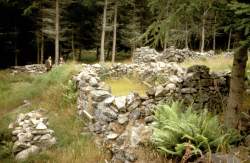 Forests of history
Forests of historyArchaeological evidence constitutes a major component of the historic environment and it is both finite and non-renewable. The types of archaeological remains found within Britain’s woods and forests are diverse and include:
Features such as saw pits and charcoal platforms are directly related to the history of their surrounding woodland. Other monuments such as burial mounds or military training camps are coincidental to surrounding woodland environments. The terms archaeology “of woodland” and “in woodland” are often used to distinguish these two groups. The Forestry Commission is committed to conserving both.
There are thousands of known archaeological sites in Britain ranging from extensive field systems and hill forts to single standing stones and sites of artefact finds. However, the total archaeological resource of Great Britain is unquantifiable. Nevertheless, with over 2.7 million ha (27 000 km2) of land in Great Britain currently under woodland management, it is inevitable that this includes many thousands of sites of archaeological interest. Depending upon a wide range of site specific variables, tree presence or removal can be either benign or detrimental to archaeological evidence.
The optimum management of a site is dependent upon many factors, all of which need to be considered when developing management plans. Indefinite preservation of archaeological evidence in situ is impossible, as it inevitably deteriorates with time. However, as many sites are not properly recorded and others remain unknown, the rate of degradation can be greatly influenced by site management. But, there is a limited understanding of the many complex interactions that influence the rates of change, especially in a woodland context.